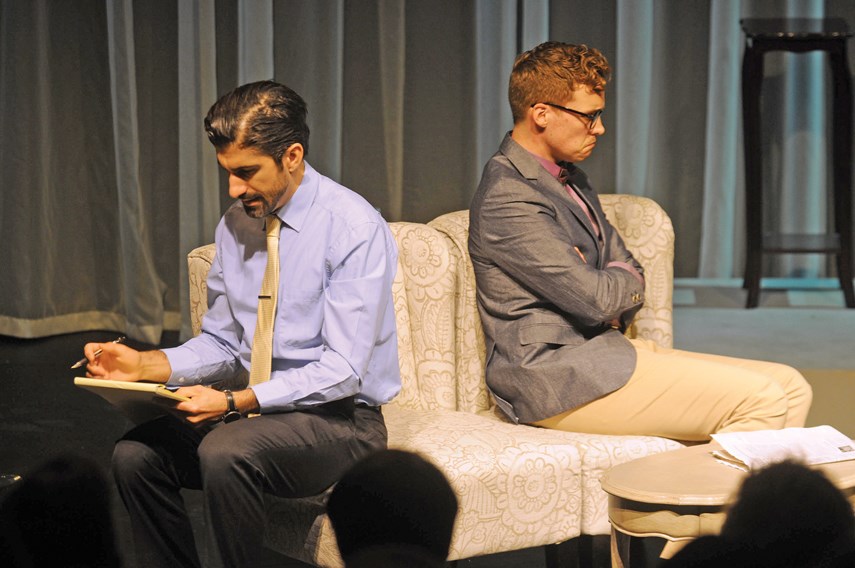The Best Brothers, Kay Meek Studio Theatre, May 8 - 19. Tickets: $29/$45 available at .
Look at your brother.
He got the same 46 chromosomes from the same parents you did but, well – look at him. He eats this, goes there, and sees nothing wrong with going out in public and doing that.
Despite being about 50 per cent genetically identical, siblings can seem like strangers linked only by a common bunkbed.
Whether it’s Michael leaving the Jackson Five, Roman Emperor Caracalla murdering his younger brother or Tommy Smothers bickering with Dick, the root of that sibling unease can be reduced to five words: “Mom always liked you best.”
The strain between siblings is the subject of The Best Brothers, a modern work that tells the story of two brothers with the last name Best (a-ha!) coping with the loss of their mother, Bunny Best.
Bunny’s death, which involves a Pina Colada but not in the way you might think, leaves sons Hamilton and Kyle to deal with possessions, memories and a dog that still seems to belong to Bunny.
Director Sharon Bajer first saw the Daniel MacIvor-penned play at the Stratford Festival, where, fittingly enough, she was studying to be a director.
“With the death of their mother they’re forced to make all these decisions,” she says. “Any tension between them, of course, comes out during that process.”
She was compelled by the play’s ability to be relatable and simultaneously “out there,” she says. For the Kay Meek production, Bajer cast Aidan De Salaiz as the tightly-wound, moderately repressed Hamilton and Ryan James Miller as Kyle, whose own blood pressure seems to move in inverse reaction to his brother’s.
Bajer worked with the actors to ensure everyone knew the meaning behind the play’s references, such as when the brothers recall Bunny mentioning the hallucinogen ayahuasca.
“We had to all look into that,” she says with a chuckle.
But what was key for the actors was “a real connection to their own mothers,” Bajer says. “You can’t fake that.”
The play is for: “Anyone who’s ever had a sibling and anyone who’s ever lost a loved one and had to deal with . . . all of the things that you have to deal with after somebody dies,” she says.
The obligations that come along with the death of a parent are alluded to in the show’s between-scene transitions, Bajer explains, or what MacIvor calls “meta sequences.”
“Each transition kind of tells a little story,” she says, discussing the emotional progression of the brothers during the cardboard box and duct phase of the grieving process.
“Letting go is when you pack up the house,” she says.
The play gives both brothers an opportunity to play their mother, allowing the audience a slanted view of who Bunny was as well as what she left.
While veering between tears and tears of laughter, the play is ultimately life-affirming, Bajer says.
A director, writer and actor, Bajer is directing the play while awaiting the release of a Lifetime movie tentatively titled: Nellie Bly. The movie, which focuses on journalist Bly’s 1887 expose of a New York lunatic asylum, has Bajer playing a “horrible, Nurse Ratchett-type . . . that does all the torturing.”
“Love it,” she says, when asked about playing a villain.
A professional actor for more than 20 years, Bajer has taken cover from suddenly-sentient big rigs rolling toward world domination in the TV movie Trucks and she’s tangoed with Richard Gere while working as a rehearsal actress on Shall We Dance? However, her voice takes on the greatest resonance when talking about her youth in Delta.
From kindergarten to Grade 6 she would retrieve costumes from her tickle trunk and outfit all the kids on her block before leading them through pageants influenced by Steve Martin’s King Tut or Bajer’s comedy idol Carol Burnett.
The short distance between her childhood passion and her professional career can be measured with a roll of gauze, she says.
As a child, she used gauze to make her parent’s garage look like a theatre. As a professional director, she used gauze to make a theatre look even more like a theatre.
“Nothing has changed,” she says with a laugh.
The Best Brothers opens May 8 at the Kay Meek Theatre.
Take your brother.


